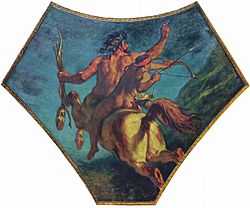Liminal being
A liminal being is one that cannot be easily placed into a single category of existence. Associated with the threshold state of liminality, such beings represent and highlight the semi-autonomous boundaries of the social world.[1]
Liminal beings are naturally ambiguous, challenging the cultural networks of social classification.[2]
Liminal entities
Victor Turner considered that liminal entities, such as those undergoing initiation rites, often appeared in the form of monsters, so as to represent the co-presence of opposites - high/low; good/bad - in the liminal experience.[3]
Liminal personas are structurally and socially invisible, having left one set of classifications and not yet entered another.[4] Mary Douglas has highlighted the dangerous aspects of such liminal beings,[5] but they are also potentially beneficent. Thus we often find presiding over a ritual's liminal stage a semi-human shaman figure, or a powerful mentor with animal aspects, such as a centaur.[6]
By extension, liminal beings of a mixed, hybrid nature appear regularly in myth, legend and fantasy.
Legendary liminal beings
A legendary liminal being is a legendary creature that combines two distinct states of simultaneous existence within one physical body. This unique perspective may provide the liminal being with wisdom and the ability to instruct, making them suitable mentors, whilst also making them dangerous and uncanny.
Many beings in fantasy and folklore exist in liminal states impossible in actual beings:
Hybrids (two species):
- Centaurs from classical mythology, among them Chiron, the mentor of Achilles
- Yali (Hindu mythology)
- 'a liminal figure, like the Sphinx...straddling the divide between animal and human, and partaking of both'.[7]
Both human and spirit by blood:
- Merlin is a Cambion, the son of a woman and an incubus[8]
- Caliban in William Shakespeare's play The Tempest.
- Abe no Seimei, legendarily attributed a human father but a kitsune (fox spirit) mother
Both human and vegetable:
- the Green Man
Both alive and dead:
- ghosts, among them Tiresias, the dead seer whom Odysseus consulted in the underworld, in the Odyssey
Both human and machine:
- In science fiction, liminal beings include cyborgs, such as the Bionic Woman and Seven of Nine from Star Trek.
Both human and alien:
- hybrids or adoptives torn between their human and alien natures, such as Spock from Star Trek or Valentine Michael Smith from Stranger in a Strange Land.
See also
- Abjection
- Anthropomorphism
- Donna Haraway
- Improvisation
- Lycanthropy
- Transitional object
- Trickster
- Virtual reality
References
- ↑ Frank Musgrove, Margins of the Mind (Taylor & Francis) p. 8
- ↑ Dean A. Nicholas, The Trickster Revisited p. 37
- ↑ J. C. Alexander and S. Seidman, Culture and Society (Cambridge 1990) p. 147-9
- ↑ Thomas Quartier, Bridging the Gaps p. 103-4
- ↑ Llynne Hume, Portals (2007) p. 110
- ↑ Aniela Jaffe and Joseph Henderson, in C. G. Jung ed., Man and his Symbols (London 19780 p. 261-2 and p. 101
- ↑ Teresa de Lauretis, Freud's Drive (Basingstoke 2008) p. 119
- ↑ Katharine Briggs (1976) An Encyclopedia of Fairies, Hobgoblins, Brownies, Boogies, and Other Supernatural Creatures. New York, Pantheon Books. "Wizards" p.440 ISBN 0-394-73467-X
Further reading
- John Clute and John Grant, The Encyclopedia of Fantasy
